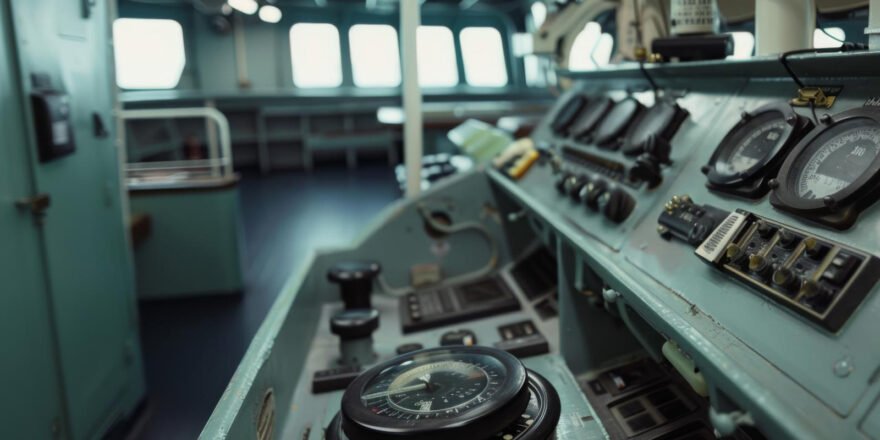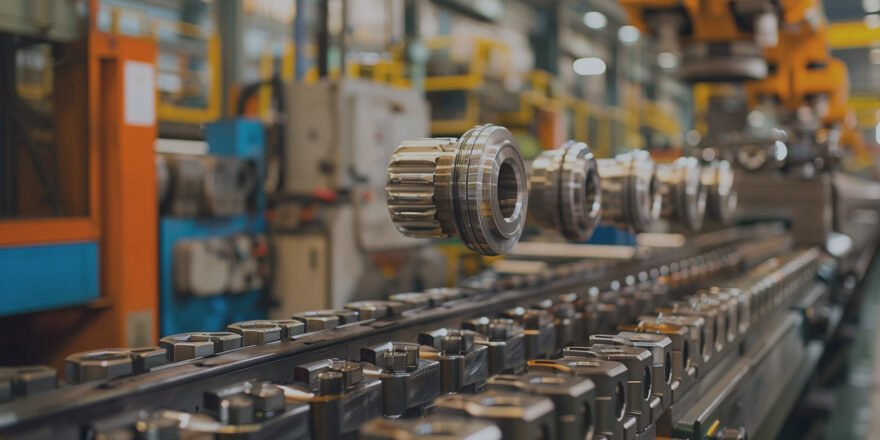The marine hydraulic system is valued for its ability to deliver high power with compact equipment on a vessel. Marine hydraulic motors and pumps are core components of the marine hydraulic system.
A hydraulic pump converts mechanical energy, usually supplied by the vessel’s main engine or electric motor, into hydraulic energy by pressurizing oil. This pressurized fluid then becomes the driving force for numerous shipboard systems. Depending on the application, vessels utilize various types of pumps, including gear pumps for straightforward, robust operations, vane pumps for smoother flow, and piston pumps for demanding, high-pressure applications.
On the other hand, hydraulic motors perform the reverse function. They take the pressurized fluid delivered by the pump and convert it back into mechanical energy, producing rotary or linear motion as required. These motors are essential in powering machinery that requires high torque and precise control, such as winches, cranes, and steering gear. Types of motors commonly found in marine use include gear motors for lighter applications, vane motors for moderate torque and speed, and piston motors for demanding equipment that handles heavy loads.
Together, hydraulic pumps and motors form a closed-loop system that drives many critical shipboard functions. They are widely used in steering gear systems for maneuverability, deck machinery like windlasses and davits for safe cargo handling, as well as stabilizers, bow thrusters, hatch covers, and ramps. Their ability to deliver consistent performance under harsh marine conditions makes them indispensable to efficient and reliable vessel operations.
It is imperative to have a trusted marine spare parts supplier that can cater to your vessel’s needs seamlessly and allow for a smooth sail.
Types of Marine Hydraulic Pumps
Marine hydraulic pumps are responsible for creating hydraulic power by pressurizing oil. Different types are used depending on the pressure, efficiency, and application needs:
- Gear Pumps: These are simple, durable, and cost-effective. They work by trapping oil between gears and the pump housing. Gear pumps are commonly used in steering gear systems, lubrication circuits, and auxiliary deck machinery because of their ruggedness and ease of maintenance
- Vane Pumps: Vane pumps use sliding vanes inside a rotor to move fluid. They provide smoother and quieter operation compared to gear pumps and are well-suited for medium-pressure applications. On ships, they are often used in hydraulic control systems where steady flow is important
- Piston Pumps: These pumps are designed for high-pressure and high-efficiency applications. They use reciprocating pistons to pressurize the fluid and can deliver large amounts of power in a compact size. Marine piston pumps are typically used in heavy-duty systems such as stabilizers, cranes, winches, and thrusters
Types of Marine Hydraulic Motors
Hydraulic motors perform the opposite role of pumps by converting hydraulic energy back into mechanical energy. Their design and type determine how much torque and speed they can produce:
- Gear Motors: Built similarly to gear pumps, these motors are economical and robust. They are used in applications where high speed and lower torque are sufficient, such as small deck machinery or auxiliary drives
- Vane Motors: Vane motors provide moderate torque and speed control, delivering smoother performance than gear motors. They are commonly used in marine applications that require a balance of efficiency and compact size, such as steering and auxiliary systems
- Piston Motors: These are the most powerful and efficient type of hydraulic motors. With high torque output and excellent control, they are ideal for demanding marine machinery like winches, anchor handling equipment, and propulsion support systems
Importance of Hydraulic Systems in Marine Operations
Hydraulic systems are critical to marine operations because they provide the power, control, and reliability needed to run a wide range of onboard machinery. Vessels operate under challenging conditions where equipment must handle heavy loads, precise movements, and continuous duty. Hydraulic systems excel in these environments because they can transmit large amounts of power through compact components, making them both space-efficient and highly effective.
One of the main advantages of hydraulic systems is their ability to deliver consistent and smooth operation. Controlling a ship’s rudder, operating cargo cranes, or running winches and windlasses, hydraulics allow for precise motion and high torque output. Unlike purely mechanical systems, hydraulics reduce strain on equipment while ensuring smoother handling of heavy-duty tasks.
Hydraulics are also valued for their versatility. A single hydraulic power unit can drive multiple systems such as steering gear, hatch covers, stabilizers, bow thrusters, and deck machinery. This not only simplifies a vessel design but also reduces maintenance complexity. Additionally, hydraulic systems can be designed for redundancy, ensuring critical operations like steering or anchor handling remain reliable even in emergency conditions.
In essence, the importance of hydraulic systems in marine operations lies in their ability to combine power, precision, and reliability. They help ships manoeuvre safely, handle cargo efficiently, and perform essential functions without interruption, making them an indispensable part of modern marine engineering.
How to Choose the Right Hydraulic Pump or Motor for Your Vessel
- Identify whether the system requires high torque, low speed, or continuous moderate power
- Match pump/motor type to application (e.g., gear/vane for lighter tasks, piston for heavy-duty)
- Ensure pressure ratings and flow capacity match existing hydraulic systems, and verify space availability and installation requirements onboard
- Choose corrosion-resistant designs suitable for harsh marine environments, and opt for proven, reliable models to withstand continuous heavy-duty use
- Look for pumps/motors that allow easy servicing and quick part replacements
- Confirm spare parts availability through trusted ship spare parts suppliers
- Select high-efficiency units to reduce fuel consumption and operating costs that balance upfront cost with long-term performance benefits
- Choose equipment that meets marine regulations and classification society approvals
- Prioritize safety features and reliable operation under all conditions
Common Issues in Marine Hydraulic Systems
- Overheating is caused by excessive load, poor cooling, or low oil levels, which leads to reduced efficiency, fluid breakdown, and component wear
- Low Pressure or Loss of Power, often due to pump wear, internal leakage, or clogged filters, resulting in sluggish machinery and reduced performance
- Noisy Operation caused by air in the system, low oil level, or blocked suction lines can damage pumps and motors if not corrected
- Oil Leakage, which is commonly due to worn seals, damaged hoses, or loose fittings, creates safety hazards and reduces system efficiency
- Erratic or Slow Response caused by contamination, sticking valves, or incorrect pressure settings, affects precise operations such as steering gear or winches
Troubleshooting Tips
Here are some troubleshooting tips to help identify and resolve issues in your vessel’s hydraulic system:
1. Monitor system temperature and oil levels regularly to prevent overheating.
2. Check for leaks, loose fittings, and worn seals when oil loss or low pressure is suspected.
3. Inspect and clean filters to avoid clogging that can reduce performance.
4. Listen for unusual noises which may indicate air in the system or blocked lines, and take corrective action.
5. Test system response by operating controls and checking for delays, which may signal contamination or faulty valves.
| Part to check | What to check | Action to take |
| Check Hydraulic Fluid | Ensure correct oil level and grade | Replace contaminated or degraded fluid promptly |
| Inspect Filters and Strainers | Clean or replace clogged filters to restore flow and pressure | Regular maintenance prevents costly downtime |
| Examine Hoses and Connections | Tighten loose fittings and replace damaged hoses/seals | Look for visible leaks or worn-out rubber parts |
| Bleed Air from the System | Remove trapped air to prevent cavitation and noisy operation | Check suction lines for proper sealing |
| Monitor Operating Temperatures | Ensure cooling systems are functioning | Avoid continuous overloading of pumps and motors |
| Check Pressure and Flow Settings | Verify system pressure matches equipment specifications | Adjust relief valves if necessary |
| Schedule Regular Maintenance | Follow the manufacturer’s guidelines for inspection and servicing | Keep records to detect recurring issues early |
Key benefits of using OEM and genuine spare parts:
- Genuine spares are manufactured to meet the original equipment standards, ensuring consistent performance and durability
- OEM parts are designed specifically for your machinery or vessel, reducing the risk of mismatches or installation issues
- Authentic parts minimize the chances of breakdowns, failures, or accidents, which can occur with counterfeit or low-quality alternatives
- Using genuine parts reduces wear and tear, extending the lifespan of engines, pumps, and other marine equipment
- While cheaper spares may save money upfront, OEM parts lower long-term costs by preventing frequent repairs and replacements
- Many manufacturers honor warranties only if genuine spares are used, safeguarding your investment
- Authentic parts ensure your equipment operates at its designed capacity, leading to optimal fuel efficiency and reduced downtime
- OEM spares often come with after-sales service, technical support, and traceability for future procurement needs
How Navallance Supports Shipowners with Hydraulic Solutions
Navallance supports shipowners with end-to-end ship spare parts suppliers providing OEM and genuine pumps, motors, valves, and control systems from trusted global brands, ensuring seamless vessel operations. With a deep understanding of the marine industry’s demands, we provide tailored procurement, 24/7 support, and fast logistics to minimize downtime and keep vessels sailing efficiently. Our commitment to quality, reliability, and cost-effective solutions makes Navallance the trusted partner for all marine hydraulic requirements.


